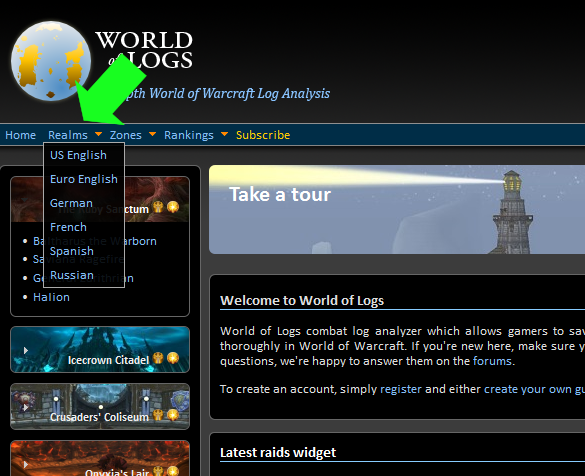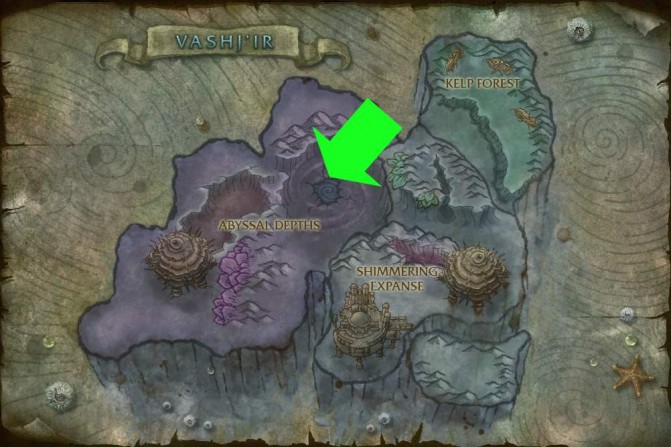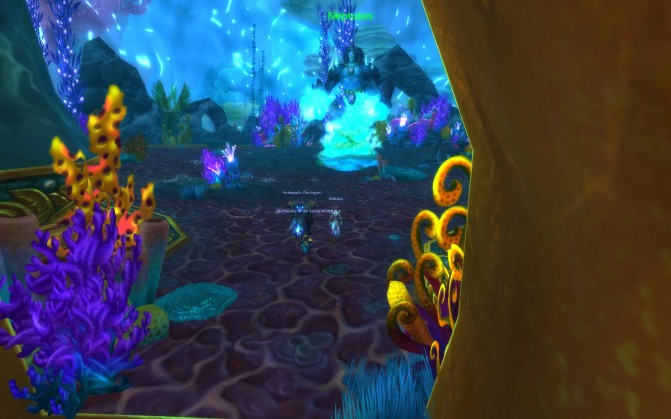
With the ICC buff up at 30% and ICC as close to ‘on farm’ as it’s probably going to get, I’ve noticed myself getting quite sloppy with my healing of late, a sentiment expressed by others I raid with. I decided to take the time to do something about it.
Why bother?
A valid question. After all, we’re mostly farming bosses, and we’re on a raid break probably until Cataclysm, so what does it matter if I ease off a bit for the next few months.
Well, first and foremost, pride. When I write on guild applications that I strive constantly to improve my character and my play, I really mean it. Like most people I’ll admit to coasting from time to time, but regression is a different matter.
Yes, regression, the opposite of progression. When you stop being able to conquer bosses that you vanquished with ease mere weeks or months ago, when ‘farm’ bosses give you pause despite the hike in power provided by Hellscream’s Warsong, it’s time to take a good hard look at how you’re playing and pull your socks up.
From a more practical point of view, healing in early Cataclysm is likely to be a lot more demanding, especially if I want to enjoy the same success I have in this expansion. So carrying bad habits over will be doing myself, and my raid team, a disservice. We like to think that we know we’re slacking but we could pick up our game whenever we wanted, but bad habits can be trickier to break than we think; so the earlier I start, the better.
The process
This sort of thing is the bread and butter of management consultants and the like. You’re looking at an iterative process, with the following basic structure:
- Create a snapshot of your performance
- Analyse your performance and identify both strengths (to make sure you retain them) and weaknesses (areas to work on)
- Make your change(s)
- Create another snapshot of your performance, to check that you’re actually making a difference and quantify its significance.
Obviously, you can (and should) go around this loop indefinitely, identifying new areas for development, making changes, then evaluating them. That’s what a good healer should be doing all the time.
Let’s take the stages in turn.
Setting a baseline
The first item on the list is to create a snapshot of your current performance. This is important so you have ‘before’ and ‘after’ pictures for comparison. Humans are prone to all sorts of mental foibles, amongst them confirmation bias (we tend to remember information which supports our beliefs and forget information which disagrees with us) and the placebo effect (where we perceive an effect simply because we believe there should be one), so it’s vital to have some relatively objective evidence to use in our evaluations.
By far and away the best tool available to you at the moment, in my opinion, is World of Logs. It’s a free service that allows you to upload combat logs from WoW, digests them, and presents you with the information in a much more flexible and easily analysed form.
Your guild might already have someone uploading logs to the site, so it’s worth asking around first to see if they have an archive you can look at.
I’m not going to go into how to use WoL in detail, because Vixsin has written two absolutely outstanding guides to WoL, which do a great job of explaining the ins and outs of the tools, and I can do no better than to suggest you go read them. The first is a basic introduction with details on how to make logs, upload them, and some basic analysis techniques. The second focuses on healer log analysis in particular. I’ll deal with what to look at in WoL reports in the next section.
As well as, or instead of, WoL reports you can use screenshots of tools like Recount or Skada as a permanent record. Make sure you hover over, or click on, your bar for a more detailed view though; just a screenshot of “winning the meters” isn’t likely to be very informative. Don’t forget to record any special assignments you had or other unusual circumstances in the encounters which might affect the results.
The other thing that I find valuable is to record observations and impressions at the time. So if you seem to be having trouble keeping tanks up, make a note. If you find yourself stressed out and frantic, make a note. If you find yourself throwing Smites or Lightning Bolts out of boredom, make a note of that as well.
I did say earlier that we needed objective evidence and clearly this is not, especially in the ‘after’ snapshot, but this is used not for decision-making but to add context to the hard data. Always remember that the WoL data is correct, and don’t let your impressions trump the facts.
The most striking use of this information is to compare what you thought you were doing to what you actually were doing. You might remember near-perfect uptime on Earth Shield or Weakened Soul on your tank, but It’s often sobering to look at what actually happened.
Analysis
From this point on, I’m going to assume you’ve either read the above-linked posts, or have some experience with WoL already, so I won’t always get into the nuts and bolts.
There’s a lot of information in a WoL report, far more than I can hope to discuss in a single article, so I wanted to focus on a few areas I think are the most important.
Overhealing
This used to be a big deal, and probably will be again come Cataclysm; it’s slipped from favour as a measure of healers in WotLK, because relatively limitless mana and extremely high raid and tank damage has led to what Vixsin referred to as a shift from “just-in-time healing” to “just-in-case healing”, where instead of only letting a heal land if it would be needed, and choosing an appropriate heal for the task, now we’re constantly casting heals and letting them land, just in case the tank takes a big hit. We rate the opportunity cost of a wasted GCD far higher than the mana cost of even 100% overheal.
However, keeping a rein on your overhealing while remaining successful is nonetheless a useful exercise. It can show that you are able to anticipate upcoming damage and heal the right people, that you are a quick responder since overhealing suggests that others have beaten you to the heal, and gives you time to think.
In World of Logs, the place to do this is to choose an attempt or a boss (I always keep to one boss, and preferably one attempt, at a time, since the different mechanics between bosses can complicate the analysis), then click on your name and choose the “Healing by Spell” tab.
Overhealing is shown in the far right column, as a percentage of the healing done by that spell.
Clearly you’ll need to make your own decisions about the numbers there, but there are some general rules of thumb:
- AoE heals (Circle of Healing, Wild Growth and Chain Heal) are likely to have quite high overhealing. Chain Heal might be a special case, seeing as it’s one of the Shaman’s better heals, but if Circle of Healing or Wild Growth have very high overhealing then perhaps they could be used at better moments.
- HoTs are another area where you’re likely to see high overhealing, except on aura fights like Sindragosa or Professor Putiricide. This is a side-effect of the general approach of HoT blanketing, where a large proportion of the ticks will actually go to waste. This is classic just-in-case healing. You can combat this by focusing on players who are actually taking, or likely to take, damage, although the Wrath healing model doesn’t favour this.
- Shields are like HoTs, in that they tend to be used widely, but can end up being largely overhealing if their recipient fails to take any damage. Ideally shields should be cast only on those likely to take damage. Also bear in mind that a lot of shields cast on the raid can push HoT overhealing very high, since ticks while the target is shielded are wasted. As Kinaesthesia pointed out on the Circle of Healing podcast, there’s nothing more fun than watching Rejuv pop up on your raid members and smacking your PW:S on immediately!
- If your overhealing on direct heals is very high, consider your target choices. Faster healers and spells are likely to be beating you to the heal, so you could try picking on people with smaller HP deficits (so smart heals don’t pick them as often) or anticipate the damage and either pre-cast or react quicker.
If, after considering all this, you find yourself with little to do to reduce your overhealing besides not casting, that might be a sign that your raid is healer-heavy. But it might also be that the healing requirements change throughout the fight, so don’t panic if you feel like your healing is unnecessary on Phases 1 and 2 of Professor Putricide, for example.
Spell Selection
On the same WoL page as before, you can see what proportion of your healing came from each spell. There are two main uses for this information: evaluating the importance of talents and glyphs, and checking that you’re using enough of your tools.
The former is the most straightforward to understand. Using a Priest example, points in Divine Fury are probably wasted if Greater Heal accounts for a tiny fraction of your healing. For a Shaman, an example might be points spent in Healing Way, or selecting the Glyph of Lesser Healing Wave.
Sometimes it takes hard numbers to prove to yourself that no, you don’t actually cast that spell as often as you think, and maybe you should lose those points.
Evaluating whether you’re using enough of your toolbox is a more tricky problem, and will depend strongly on your raid and assignment. This is an area where comparisons between yourself and others of your class are valuable. If you’re the only one playing your particular spec in your raids, either browse World of Logs for other guilds’ logs or ask other healers for logs to compare with.
You can browse the other guilds on your server who are uploading logs either by clicking on your realm name in the upper left (if you’re looking at a guild already) or by clicking on “Realms” and browsing to your region and server. The advantage of picking guilds on your server is that you are likely to be able to eyeball a guild’s progression level, and you’re more likely to be able to engage those players in conversation if you want to try asking them questions directly.
Even if you can’t, or don’t want to find other logs to compare yourself to, you can have a look at your healing by spell and see what it looks like.
The first step is to make a list of your “core” spells, and check that they’re all getting some usage over a night or over a fight. For a Disc Priest, my list would be:
- Power Word: Shield
- Prayer of Mending
- Flash Heal
- Binding Heal
- Penance
- Divine Hymn
Note the last item on that list, Divine Hymn. Make sure that you’re actually using your cooldowns, and if they’re not getting much use, think about where you can use them to best effect. Saving cooldowns for a rainy day is all well and good, but if you find you never need them then it’s probably safe to spend them for a quick boost.
Nowhere in here have I tried to tell you what spells to use; only you know what it’s like healing in your raid team (informed by your observation notes, of course). The aim of this exercise is simply to make you think about your spell usage and consider if you might wish to make any changes.
Activity
Now that we’ve explored whether we’re using a wide enough range of our spells, and whether those spells are appropriate, timely and necessary, the final thing to check on is our activity: put simply, are we casting enough?
The best way to measure our activity is to use a more advanced feature of World of Logs, the Expression Editor. Some of this section is inspired by posts by Auracen at PlusHeal, heavily adapted.
I’ll take this step by step:
- Choose the time period you’re interested in and select it from the top menu. A single attempt or kill is best, to avoid confusions caused by downtime or trash.
- From the Dashboard menu, choose Expression Editor
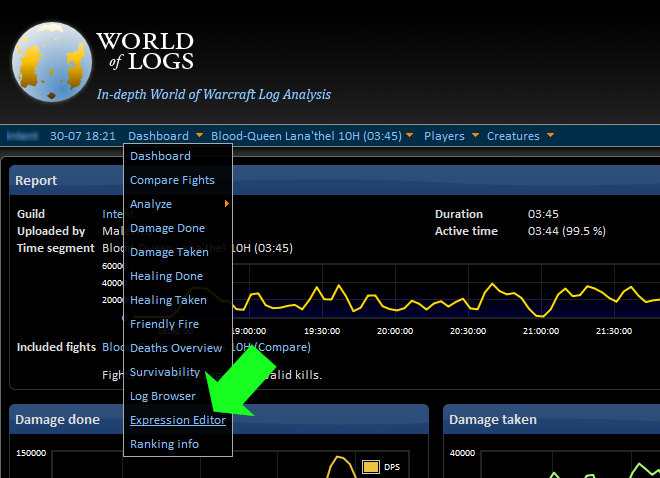
- In the Query box, paste one of the following expressions, depending on your spec, remembering to replace “Malevica” with your name near the beginning of the expression:
Discipline Priest
SourceName = "Malevica" and (fullType = SPELL_CAST_START or fullType = SPELL_AURA_APPLIED or fulltype = SPELL_CAST_SUCCESS) and (spell = "Power Word: Shield" or spell = "Flash Heal" or spell = "Greater Heal" or spell = "Binding Heal" or spell = "Prayer of Mending" or spell = "Penance" or spell = "Divine Hymn")
Holy Priest
SourceName = "Malevica" and (fullType = SPELL_CAST_START or fullType = SPELL_AURA_APPLIED or fulltype = SPELL_CAST_SUCCESS) and (spell = "Circle of Healing" or spell = "Prayer of Healing" or spell = "Flash Heal" or spell = "Greater Heal" or spell = "Binding Heal" or spell = "Prayer of Mending" or spell = "Renew" or spell = "Divine Hymn")
Resto Shaman
SourceName = "Malevica" and (fullType = SPELL_CAST_START or fullType = SPELL_AURA_APPLIED or fulltype = SPELL_CAST_SUCCESS) and (spell = "Chain Heal" or spell = "Riptide" or spell = "Lesser Healing Wave" or spell = "Healing Wave" or spell = "Earth Shield")
Resto Druid
SourceName = "Malevica" and (fullType = SPELL_CAST_START or fullType = SPELL_AURA_APPLIED or fulltype = SPELL_CAST_SUCCESS) and (spell = "Rejuvenation" or spell = "Regrowth" or spell = "Wild Growth" or spell = "Nourish" or spell = "Lifebloom" or spell = "Swiftmend" or spell = "Tranquility") and healSpellId != 70691
Holy Paladin
SourceName = "Malevica" and (fullType = SPELL_CAST_START or fullType = SPELL_AURA_APPLIED or fulltype = SPELL_CAST_SUCCESS) and (spell = "Holy Shield" or spell = "Flash of Light" or spell = "Holy Light" or spell = "Holy Shock" or spell = "Aura Mastery" or spell = "Divine Sacrifice")
NB: WordPress was converting the " " marks to smart quotes, which would have caused WoL to error if you copied and pasted straight from this post. It’s now fixed, sorry about that! - Press the “Run” button.
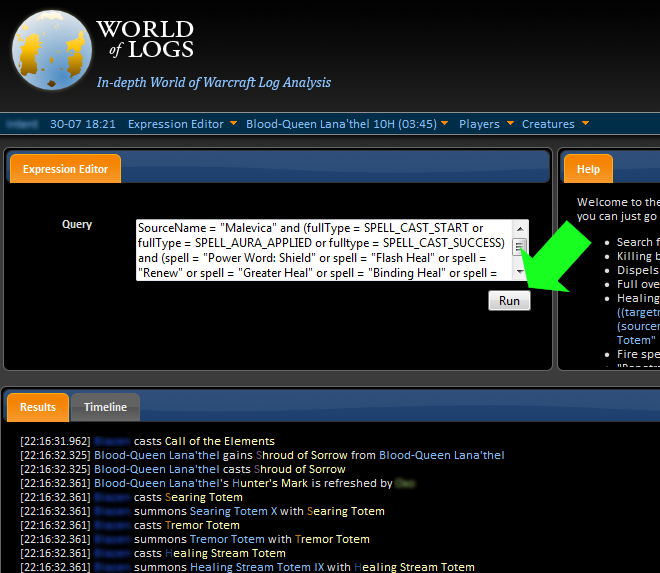
Hopefully some lines have gone from the list of combat log events, but some still remain. If none remain, you’ve got something wrong in your query, so check again that you’ve copied and pasted the expression correctly and put your name in their, rather than mine.
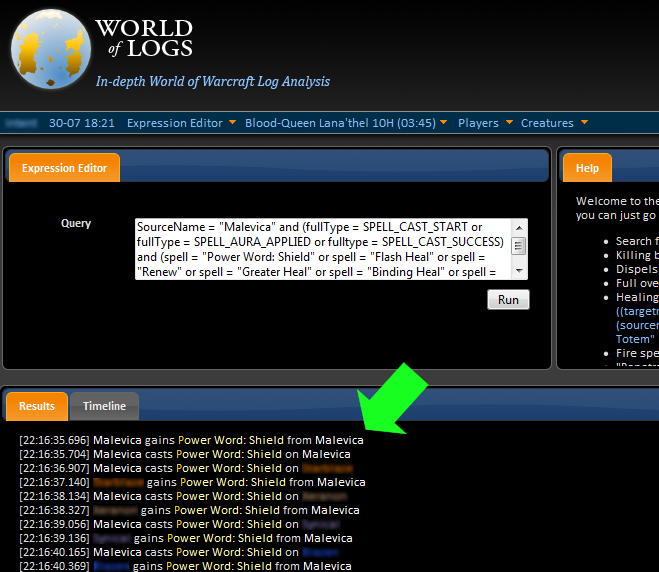
- A list of events might be what you’re looking for, but information like this is usually better represented visually. World of Logs has the ability to display a timeline of your actions over time.
To bring this up, click on the Timeline tab and then click on the Plot Spells Timeline button.
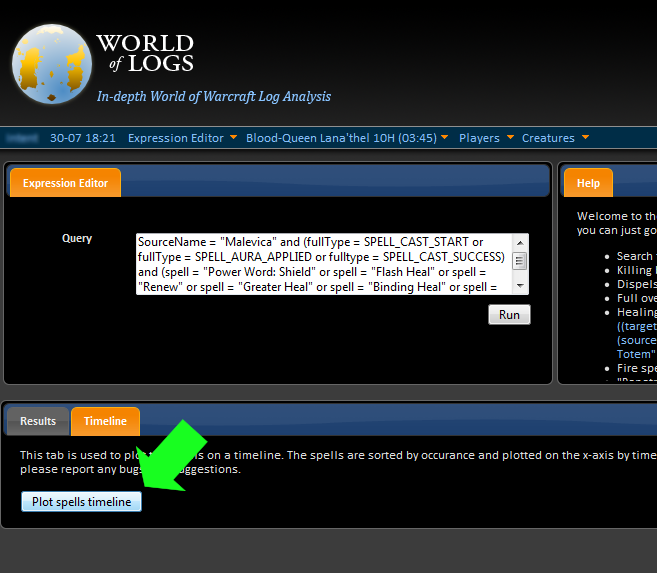
The result should look something like the example below:
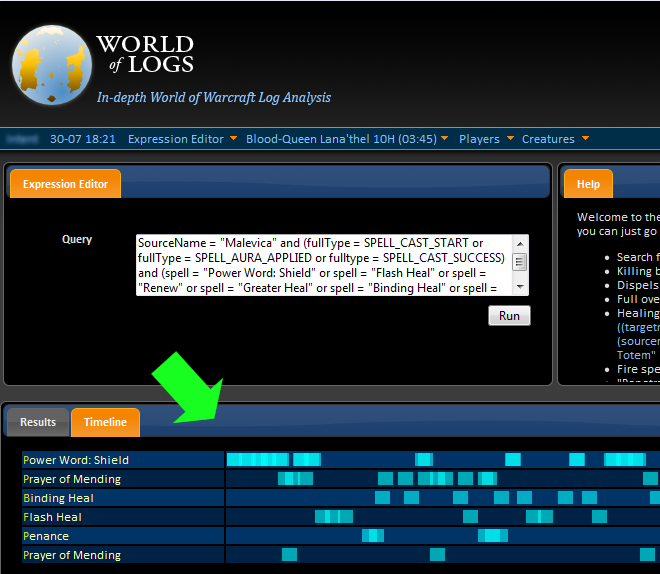
What you can see at a glance on this plot is the number and range of different spells you cast, and if you have a ‘rotation’ you can see how well you’re able to stick to it in practice.
In the example above, you can see that I tended to get distracted and I don’t get my shields refreshed on time every time, but there are a few clear blocks of PW:S casts, showing I’m using it fairly regularly on the whole. I’m also underusing Penance, which is probably hurting my output. I’m casting a wide smattering of spells, which might indicate a lack of discipline (no pun intended) or a reactive role, I’ll need to think a bit more about that.
On the plus side, I am getting plenty of use out of Prayer of Mending (see the little clusters as it bounces almost immediately), and I’m remembering to mix Binding Heal in with Flash Heal to keep myself alive at the same time as healing the raid.
Looking at the picture overall (I find squinting helps), I’m pretty busy throughout the fight without there being many big gaps in my casts. This view can help to highlight players with gappy timelines who might be slow to react, be distracted or AFK, who don’t heal well on the run, or who might just be waiting around for something to heal, depending on the players in question.
Making a change
Once you’ve identified areas you want to work on or tighten up in your play, obviously you need to actually make a change. Easy right? Well for some people it might be as simple as saying “I need to cast Prayer of Mending more” and having it happen, but almost everyone will need some amount of time and support to implement a change.
The first thing to stress is that it will take time and practice, there’s no way around that. You can heal the target dummies (could have sworn this worked, apparently it doesn’t, sorry!) yourself easily enough if you want to work on a rotation or practise keeping a spell on cooldown, or you can just get stuck in and raid; your best bet will be some combination of both.
My strong suggestion would be to pick one thing at a time and focus on that. If you try to change too many things at once you’re likely to forget about some or all of them and you won’t be anything like as effective as you could be. In my case, I’ve been working on improving my use of Prayer of Mending, trying to throw it out pretty much as soon as it comes of cooldown, so I’ll take that as a simple example.
What you do to actually improve depends on what works for you and what you’re trying to improve.
- In my case I set up a PowerAura to flash up whenever Prayer of Mending was off cooldown, so I was reminded to cast it more often.
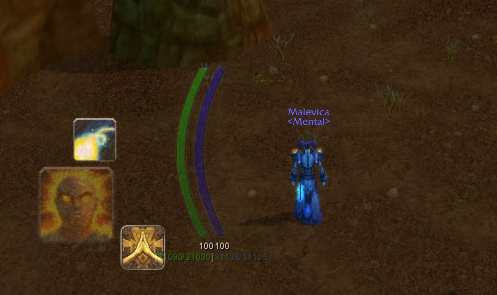
- If you’re trying to improve your range of spells cast, perhaps unbind your most common spell to force you to play with your alternatives to find something which works instead (best used in a safe environment, at least at first, but using this in a raid can be a very powerful lesson).
- If you’re trying to increase your actions per minute, pick up a castbar addon like Quartz, or Az Castbar (ACB) which has a latency display built in, and start your next cast as soon as you’re within the red or green zone, as in the screenshot below:
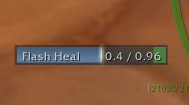
Alternatively, just keep your standard “filler” spell on an easy binding and practise hitting it whenever you can’t think of anything else to hit. Getting into the habit of Always Being Casting is a sound habit, even for Cataclysm (you’ll not always need to heal, but most healers will have the option to DPS and get mana back for it, so learning to fill spare time is a good habit).
Did it work?
This is a step that many people can forget to include, but it’s so important to cementing the change: take another snapshot of your performance and repeat the analysis step.
Make another log, and look closely at it. Did you change what you wanted to change? Are you actually using more spells? Casting more often? Using that crucial cooldown spell more often?
If you don’t actually check, how can you know whether you’re actually making a change or if you just think you are? Remember how surprised you were when you first looked at your timeline or spell percentages or overhealing? That’s because you don’t actually remember very well, and you tend to fill in uncertainties with what you expect, not reality. So always trust the data.
Either way, give yourself a pat on the back for taking things in hand!
Rinse and repeat
Needless to say, the process doesn’t end here; either that’s because you identified more than one thing you wanted to work on, or because when you changed one thing you’ve now shifted your healing balance around and something else might now be out of kilter.
Once you’ve got your first change sorted and feeling like a comfortable part of the new healing modus operandi for your character, take the new baseline you acquired for the step above, and loop back to the Analysis step. Work out where your next area for development is, work out how to make a change, implement it and practise it, then evaluate how well it worked.
Above all, you should always be somewhere on this cycle.




